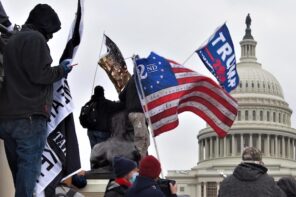This weekend’s “Unite the Right” rally made horrifically literal the portrayal of blood-soaked streets depicted in promotional posters. The organizers accomplished two political feats as well. By uniting an array of racist and fascist organizations under the cause of a Confederate monument and the banner of Nazi Germany, “Unite the Right” starkly revealed the white supremacy and white nationalism at the root of Confederate civil religion.
The rally also set up a situation where President Trump’s refusal to directly condemn white supremacism could be read as tacit support for swastika-flag-bearing celebrants of Hitler and his ill-fated Reich calling for the end of the United States. “No condemnation at all,” the neo-Nazi Daily Stormer said of Trump’s reaction, adding, “God bless him.”
Many of the rally’s architects and participants have long linked the Nazi era with “lolz” and trolling. This weekend’s event promised to “end Jewish influence in America” and ended with a Nazi sympathizer plowing his car into a crowd of American citizens. And even then Trump—not known for biting his tongue or biding his time when it comes to issuing public statements—spoke only of “hatred, bigotry and violence, on many sides,” before immediately switching the focus of concern back to himself, in the third person.
As we’ve seen before and will surely see again, even stiff-armed Nazi salutes don’t draw rebuke from the president, so long as they are done in his name. White supremacists, the so-called “alt-right,” can continue to claim Trump’s support, but there is lamentably little surprising about this—in fact it is the lesser of two victories the movement took from Charlottesville.
The second alt-right victory this weekend lies in linking support for Confederate monuments—often framed as a genteel Southern civil religion—with the explicit racist, anti-Semitic, and anti-American vitriol Trump refused to name.
By rallying a wide range of white pride, neo-Confederate, American fascist, and anti-communist organizations together with kek-meming internet trolls—some suited up in armor and others in khaki-and-polo combos possibly patterned off of the president himself—the organizers created an orgy of radicalization. Rally participants chanted together, “Jews will not replace us,” “fuck, you, faggots,” and “blood and soil.” The focus was not a public memorial of military history on a plinth in a city park, but, rather, fantasies of genocide and separation, narratives of race-based identity and rhetorical violence segueing swiftly to literal violence. Extremism had the day. As former KKK wizard, eager participant, and Trump enthusiast David Duke promised in advance, the “Unite the Right” rally was a “turning point for the people of this country.”
It represents a turning point most particularly for those who would continue to defend the statue at the ostensible center of the event, a monument to a confederate general in a park recently renamed to memorialize the end of slavery. The march organizers set out not so much to unite as to coopt, construing their own role as the “head” of the fragmented snake that, in parody of Ben Franklin’s famous revolution-era flag, must “join or die.” But joining, in this case, means signing up to match under the swastika, alongside event leaders who speak of America as a failed political experiment and describe alternate visions of a country “carved into ethno-states.”
Even those who came to Charlottesville convinced they were “patriots” found themselves under a foreign flag, marching amid calls for the dissolution of the Union. The rally was like a soup that takes the flavor of its most extreme ingredients: anti-American sentiments escalated; racist hate was amplified.
As an historical event, “Unite the Right” thus functioned like the fabled “red pill” so popular as a metaphor at the margins of contemporary political theory. The rally revealed things as they really are: an American president so self-obsessed—and worried about a shrinking base—that he remains unconcerned by Nazis calling for the end of America: an American Civil War that never ended.
Waged in bloody fashion for four years, the conflict did not end after Appomattox, but was transmogrified. The insurrection against the United States continued not only through vigilante and militia groups such as the White League and the Ku Klux Klan, the web of statutes and practices designed to exclude African Americans from exercising their rights as citizens, and in an unbroken political emphasis on “state’s rights” and the racist design of Lee Atwater’s “Southern Strategy,”
The Civil War continued, too, in the mythic reimagining, ritual reenacting, and ethical ordering of Confederate history as a frame by which to give meaning to life. This civil religion was described by Charles Reagan Wilson as the “religion of the Lost Cause,” though this name speaks in the classic double-voicedness of the Old South (think, “bless your heart” as meaning anything but). The “cause” on which this civil religion is predicated—white supremacy and white nationalism—is understood as worth maintaining at the cost of blood and never truly “lost,” merely suffering through a period of oppression which will culminate in a triumphant return. The south will rise again, or, as the words of New Orleans’s original Liberty Place monument put it, one day the “usurpers” will eventually be overthrown and “white supremacy in the South” will be “recognized.”
Monuments to the Confederacy have long served to shore up the wounds—for white southerners and their sympathizers—of a devastating conflict, a catastrophic loss, and a humiliating occupation. The canonization, as folk saints, of men who led a slavers’ secession from and waged violent war against the United States is essential to an understanding of post-Appomattox existence as, rather than one of surrender and defeat, a state of ongoing truce. This Confederate civil religion, crafted during Reconstruction and continuing to the present day, has served to keep the country tenuously united.
But as this Confederate civil religion has allowed the Civil War to continue in a state of détente, this détente allowed for Confederate desires and fantasies to exist coincident with dreams of and affiliation with America. Devotees of the Lost Cause venerated the Founders as well as the insurrectionists. They flew their battle flags alongside the Stars and Stripes. They sought not to destroy America, merely to transform it into something closer to their imagined pre-Lincoln utopia.
Hence Duke’s “turning point,” the “join or die” moment for Americans who hold to nostalgia for an Old South that never was, a General Lee who never was. “Unite the Right” forces a decision: link the battle flag claimed as “heritage” to the Nazi flag or repudiate the white supremacism and white nationalism, the anti-black fantasies and revisionist histories of slavery at the heart of Confederate civil religion. For Duke, whose romance of the Southern slavers’ rebellion has always been linked with an appreciation for Hitler and a penchant for posing in SS uniform, there is no space between these two positions, between the Stars and Bars and the Hakenkreuz.
But for many other Americans, particularly but not only in the south, the Jew haters in Charlottesville have left them with a Sophie’s choice. That such Confederate heritage and described as a “religion” not just by interpreters but by devotees indicates the depth of commitment, even the taken-for-granted aspect of the Lost Cause as a means of making sense of history and human life. Indeed, as part of the protests against the removal of monuments that “Unite the Right” seized upon, the notion of these statues as “religious” has been explicitly mobilized in their defense. Those in favor of memorials of the Confederacy have compared those who would remove such “religious statues” (elected American politicians) to terrorists.
In Virginia, Minnesotan Corey Stewart, campaigning for governor of that commonwealth, declared on Twitter in April that, with the removal of Confederate monuments in New Orleans, “ISIS has won.” On the same day, the white nationalist Daily Stormer also used the ISIS analogue, though they vented their anger at “Jewish plutocracy” and blamed “Jewish blood money” for the decision to remove the statues (and were explicit that the purpose of such monuments was for rallying “identity and strength” of white people). The neo-Confederate League of the South labels such action “ISIS-Style Cultural Genocide,” and the Sons of Confederate Veterans issued a statement deploring the “ISIS-like efforts to erase history and culture.” The analogy proliferates: “ISIS destroys religious statues too,” read a sign in Saint Louis. “We consider ISIS to be barbarians and evil for destroying ancient symbols and monuments,” reads a letter to the editor of a local paper, a venue, too, for the repetition of the ISIS analogy in online comments.
The logic here links those who would remove Confederate monuments to ISIS both in terms of occupation and of religious war. Those opposed to the monument are presented as a capricious, violently oppressive army, and outsiders to boot—power-hungry and disrespectful carpetbaggers. The comparison is also, of course, hyperbolic, as the use of an actual ISIS tactic of turning cars into weapons, at the “Unite the Right” rally, starkly reveals, just as the optics of the “Unite the Right” rally—and it was nothing if not full of photo-opportunities—reveal the bedfellows sharing a platform in relation to such statues, some with swastika armbands, some in Klan hoods, some in white polo shirts.
Yet the recognition by Lost Causers that ISIS knocks down what they claim as idols and signs of idolatry is revealing on its own, an indication of the depth of the problem and, indeed, why “Unite the Right” picked this topic to rally an array of hate-mongers around. ISIS’s campaign is that of one faith seeking to eliminate all traces of other faiths. In insisting that this is what the anti-monument parties are seeking to do, these pro-monument writers and protestors have correctly identified what is happening. Indeed, New Orleans Mayor Mitch Landrieu, earlier this summer, spoke of the Lost Cause as a “cult,” one “on the wrong side of humanity,” discourse historian of religion Martin Marty described as prophetic, a religious voice rejecting another religion as idolatry.
“Unite the Right” called attention to this, that dueling visions of America—American history and expectations for and patterns of an American future—are more than just differences of opinion, they are radically divergent worldviews, with separate systems of values, conceptions of humanity, and even understandings of the good. The problem of the proliferation of Confederate civil religion has always been what to do with a citizen who glorified secession, how to reconstruct these United States, to warring visions into one America. Dismantling shrines is far easier than squelching a robust faith. Secession and treason, on the other side, is far easier than conversion.
In purporting to rally around such a shrine “Unite the Right” sought to further divide America—quite literally, for those rally leaders who long for a sectioning of nation’s territory into separate race-based countries. In their attempt, the organizers and their torch- and shield-bearing pawns revealed what was already the case, that those loyal to the Lost Cause have always only ever been tenuously “united” with the broader project of America. This weekend presents them with their turning point: join or reject. The only choices are collaboration, complicity, or condemnation—the swastika, the flag of rebellion, of the Stars and Stripes.
With blood still fresh on the streets of Charlottesville, the mayor of Lexington, Kentucky, ordered the removal of two Confederate monuments in that city. On Sunday, the day after the violence, as details were emerging about the young woman killed and the white nationalist terrorist who killed her, protests for the removal of Confederate monuments took place Sunday in Baltimore and San Antonio, calling these memorials to white supremacism for what they were—and what the “Unite the Right” crowds reveled in their being.
Just as no American, after Charlottesville, can doubt that the current US president remains deferential to an extremist white supremacist base that rallies in his name, so too no American can pretend Confederate memorials don’t serve as public shrines to a treasonous worldview—a political philosophy and a vision for a future state, an ethics and a racist conception of humanity—that has and always will be at odds with the country against which the Confederacy rebelled.
The American Civil War claimed well over a million lives; the ongoing resistance to and subversion of Reconstruction claimed thousands more, notably through lynching and mob violence. The organizers and hooded, helmeted, and Hakenkreuz-wearing participants of “Unite the Right” may well long for more bloodshed, but at least they have clarified the terms of the “debate” regarding ongoing memorialization of insurrection against the United States.





